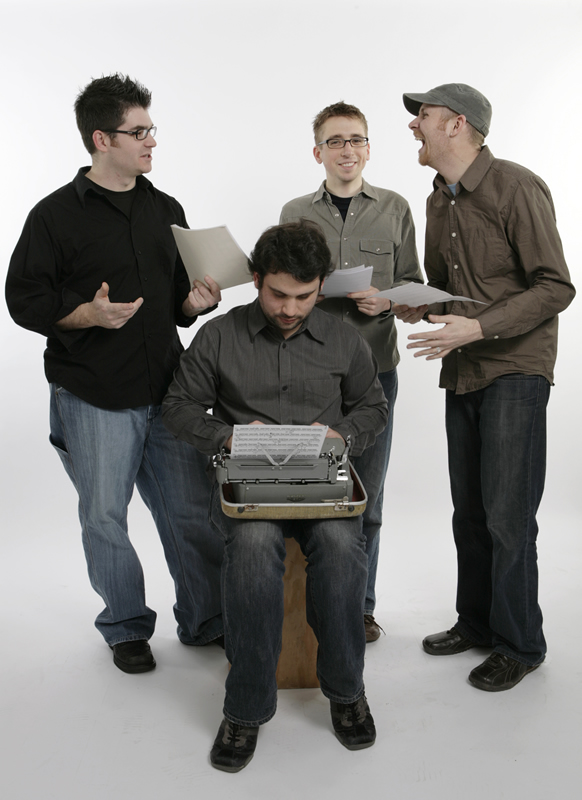Percussive Evolutions
Quinton Skinner weighs in on So Percussion's recent performance at the Southern Theater, which included the world premiere of a new work by local composer Mary Ellen Childs and pieces, old and new, by Steve Reich, David Lang, and Steve Mackey.



SO PERCUSSION‘S APRIL 29 PERFORMANCE at the Southern Theater was remarkable for the sonic palette the four-piece ensemble created using, (almost) exclusively, instruments struck by the human hand. Additionally, their program evoked a palpable sense of excitement for new music, as well as giving a virtuosic nod to the roots of these abstract soundscapes.
The opening composition, Steve Reich‘s Music for Pieces of Wood, dates back to 1973. Here the ensemble tackled its minimalist tones on marimbas (the evening was part of the Marimba 2010 International Festival and Conference), each member restricting himself to a single note. Each musician entered the piece one at a time, striking single tones that gradually evolved into more complex rhythms. By the time the quartet (and one guest) were all playing together, the amalgam of five, one-note beats coalesced into a polyrhythmic suite familiar to listeners of Reich’s iconic Different Trains or Music for 18 Musicians. The sound has become synonymous with a certain mood evoked by modernity: a busy, purposeful chatter that suggests incessant activity for its own sake. In Music for Pieces of Wood, through relentless, organized sound, So evoked action: the beeping of a telegraph, the ballet of crossing trains, the pounding of industry, the natural pelting on rainfall (nature needing her say as well). As an opener, it was an apt statement of purpose.
The next piece was a premiere by local composer Mary Ellen Childs: And So employed the quartet on marimba, vibraphone, steel drum, toy piano, and glockenspiel. It was a counterpart to the Zen restlessness of Reich’s music, drifting and then coalescing, calling to mind the dual-edged fog of a fairy tale, in which the beautiful and the frightening coexist in the same moment. The music drifted without apparent conclusion or unifying theme, which seemed to be the point, and it certainly gained in contrast to Reich’s hyper-organized compositional technique.
By the time the second piece drew to a close, there was a palpable sense of fun onstage, and the program moved from the serene to the blatantly virtuosic: a solo performance of David Lang‘s String of Pearls on marimba by So’s resident specialist Adam Silwinski. The composition is made up of a series of melodic percussive passages of increasing complexity, marked by meditative pauses that render its title profoundly descriptive. Lang composed the piece by making specific notes and rhythms, while leaving the shaping of each phrase up the performer (in the program notes, Lang describes each player’s choice as ranging from “all loud, or all quiet, or anywhere in between”). Silwinski was clearly in his element here, and the improvisational quality inherent in the piece was readily evident; he approached his performance with a clear, in-the-moment process of discovery, the physical act of playing complex rhythms merging with the cerebral and emotional process of communing with the composition anew.
The foursome then returned to Reich for Mallet Quartet, performed on two marimbas and two vibraphones. The regional premiere of a 2009 composition, this quartet both contextualized Music for Pieces of Wood and dizzyingly expanded its percussive and harmonic possibilities. On a relatively simple percussive bed of dual marimbas (reaching into very low, ominous tones at time), Reich overlaid sparkling clusters of melody on vibraphone. The marimbas, in this piece, are roughly analogous to the bass-guitar in rock music, but instead of driving a conventional song structure, each melodic phrase on the vibraphone repeats itself, changing slightly with each iteration. The effect for the listener is initially alienating, then wholly fascinating. So’s performance of the Mallet Quartet was spirited and precise, and the interplay between the four musicians fostered a sense of excitement and possibility. In three movements (“fast, slow, fast,” as described by Reich) the piece has such a cohesive internal logic that, by the end, it was entirely possible to share in the players’ satisfaction from the experience.
______________________________________________________
The evening was an invigorating evocation of the thoroughfares and byways possible in new music, delivered with an inclusive sense of play that effectively bridged the gap between the audience and the stage.
______________________________________________________
Following the intermission, it was time for the audience to take its medicine, in the form of the sprawling, 40-minute It Is Time by Steve Mackey (a new piece). This was the element of the program that was wisely left to the end, after So had established its considerable credibility, through capable execution over a range of styles, from Reich’s precision to Lang’s soulful exploration. Although it first seemed a cacophony, once one settled into the piece, It Is Time yielded its own particular rewards. It Is Time is structured to showcase each member of So Percussion in a series of four movements, utilizing electronics, toys, bells, marimba, and kitchen timers set to go off at unexpected moments. What initially seemed like self-indulgence transformed into a sense of irreverence and fun, not least via Josh Quillen‘s haunting, psychedelic steel drum and Jason Treuting’s raucous, jazz-influenced workout on a traditional drum kit.
By the end, So Percussion had delivered the point behind It Is Time: bending, warping, and shaking our very sense of time itself. It was a purposeful ending to a solid, near-perfectly constructed program. Moving us from 1973 to 2010, the evening was an invigorating evocation of the thoroughfares and byways possible in new music, delivered with an inclusive sense of play that effectively bridged the gap between the audience and the stage.
Finally, in language as in music, the silences punctuate content with as much meaning as any tone expressed. By presenting these pieces as a progression, developing from Reich’s tightly organized Pieces of Wood to Mackey’s free-form jam, So Percussion argues for the descriptive power of abstract sound: from order to chaos, then back again, much like the percussive rhythms of our days.
______________________________________________________
Noted performance:
So Percussion performed at the Southern Theater in Minneapolis April 29 & 30. The show, part of the line-up for the Marimba 2010 International Festival and Conference, featured the world premiere of local composer Mary Ellen Childs’ new work, And So.
______________________________________________________
About the author: Quinton Skinner is the author of the novels 14 Degrees Below Zero and Amnesia Nights, as well as non-fiction books on music and parenting. He has written extensively on Twin Cities theater in local and national publications. He lives in Minneapolis.